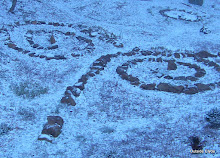First let us enjoy some most luscious 'Black Gamecock' Louisiana iris. I do believe this is the best bloom ever. And this is after I stuck a shovel in there this spring and cut a foot off the edges because it was closing off the path.
They went to good homes.
So deep, dark, rich and velvety. It always reminds me of Isabella Rossellini and Blue Velvet.
So I was minding my own business as usual, admiring the mother clump of Darmera peltata when something out of place caught my eye.
About three or four years ago a baby Darmera showed up some eight feet away from the mother plant. They had bloomed in the past and rest assured there is no deadheading in these parts. I just figured it had set viable seed at some point and one managed to emerge through the Lush.
The leaf margins were smoother and less serrated. The plant itself was a paler green. I attributed that to genetic diversity.
But whoa. What is that? It is sending up a bloom spike now and it looks completely different.
Darmera blooms in April before the leaves emerge and it is a round pink ball of small five petaled flowers. This is not that. What is going on here?
This is Darmera peltata.
What is this?
The growth habit of a single leaf rising from an underground rhizome is exactly the same. The baby was well on its way to approaching the size of the mother plant.
But the flower is all wrong. Plants are ID'd by their sex parts. Something is not right here. The flower is also very wrong for the native Umbrella Leaf, Diphylleia cymosa, of we we have plenty deep in the forest. Can genetic diversity get this far off the path? Do I have some weird hybrid of Darmera, Diphylleia, Syneilesis or Rodgersia perhaps that does have a similar flower.
What is this thing growing along the stream in the sunny utility meadow by the mother patch of Darmera? I certainly didn't plant it there.
So I went to the interwebs and started looking for new species in the closest genera to the possible.
When it is not being mind numbingly annoying, the Google machine is quite amazing. While I was doing image searches looking for flower variation, the Google was showing 'people also searched for'. These were showing pictures of similar large leaved plants.
And there it was. Mystery solved. This is Astilboides tabularis, something completely different and totally the same. Now I know who it is. How it got there is another matter.
I have a feeling some other gardeners planted it long ago. That institutional memory has been lost though. Freed from the smothering Clematis virginiana, it came back to life.
I have a new plant and nothing fell out of the ground and I didn't have to buy anything. Nice.
Meanwhile, in the roadside vegetable garden, the parsnips are in bloom.
Wednesday, June 7, 2017
Subscribe to:
Post Comments (Atom)

















3 comments:
Love to discover those surprise flowers/plants. Lucky you.
Great story! I thought of Astilboides because I have never been able to tell it from Darmera, so great photos of both. Both are pretty thuggish aren't they? But you probably like that in your setting. Wonderful find.
It was a surprise Lisa. I grilled Bulbarella because there are a number of other things in the same general area that were obviously planted by gardeners. I thought I might jar her memory. She has no recollection.
Bev, Astilboides was a new one for me. It wasn't thuggish enough to win out over a smothering mat of clematis. Now maybe it will be. About the baptisia, I grew all mine from seed, most recently B. alba. Maybe that will be more competitive with the Lush. I'll have to check out the new cultivars.
Post a Comment